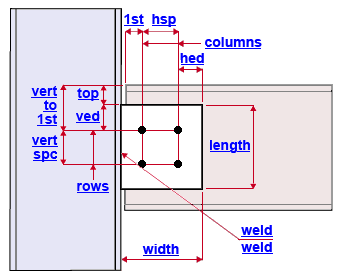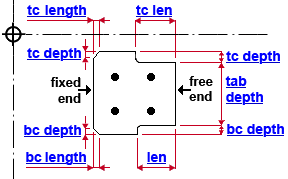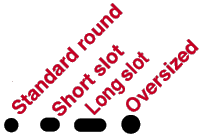"  Shear Tab " & "
Shear Tab " & "  Tab Clips and Copes " connection design locks
Tab Clips and Copes " connection design locks
|
|||||
"  |
" ( cuts made to a shear plate )  |
||||
|
|||||
Connection Guide: Click here for related screen shots. For shear plates on a tube beam , " Shear Tab " options control both shear plates.
User Defined Connections: Settings that are locked (
) in a user defined connection file will automatically be locked on a Beam Edit window for which that file is the specified " User defined connection ." You can, if you so choose, manually lock additional settings on the member edit window, and your changes will be retained, through multiple processes, so long as you do not change to a different connection then switch back to the original user defined connection.
Beam Edit: To change a setting, first set it to locked (
). Related settings that are unlocked (
) may be updated, and the "
Left/Right end limit state " calculations will be updated. Settings that are locked (
) will not be changed by connection design , even if doing so might prevent a connection failure.
Connection design locks :
| Locks not dimensioned or called out on the drawing are marked ( not depicted ). |
![]() Shear Tab
Shear Tab
Shear plate
Top of plate ( top ): The positive (+) or negative (-) distance from the top flange of the beam to the top edge of the shear plate. A positive (+) distance places the shear plate that distance below the top flange of the supported beam. A negative (-) distance places the shear plate that distance above the top flange of the supported beam. Changing " Top of plate " moves the plate, but does not move the holes. " Vertical to 1st hole " moves the holes. In the above example , this distance is positive.
End connection failure message : Invalid bolt edge distance
Plate length ( length ): The distance between the top and bottom edges of the plate (see example ). If " Plate length " is unlocked (
), changing the " Vertical hole spacing " or the number of " Rows " also changes also changes the " Plate length ."
End connection failure message: Beam not deep enough for connection
Plate width ( width ): The distance between the fixed edge and the free edge of the shear plate. The fixed edge is the edge that welds to the supporting beam or column -- see example . If " Plate length " is unlocked (
), changing the " Member edge distance " or " Horizontal hole spacing " or the number of " Columns " also changes the " Plate width ."
End connection failure message: Connection depth is less than required minimum
Plate thickness ( not depicted ): The " Material thickness " of the shear plate.
Width of stiffener opposite ( not depicted ): The distance between the two vertical edges of the stiffener opposite. You can get a stiffener opposite to a shear plate connection for a beam-to-beam framing situation when "
Stiffener opposite " is checked in "
Connection specifications" for this beam (the supported beam). The connection design lock " Width of stiffener opposite " is only available when a stiffener opposite has actually been designed. Note: The thickness and depth of the stiffener opposite are controlled by the " Plate thickness " and " Plate length " of the shear plate. Also, " Extend size to " needs to be set to something other than ' As required ' in order for a stiffener to be designed.
Relative rotation ( not depicted ): The number of degrees that the shear plate is to be rotated. A " Relative rotation " of ' 0 ' aligns the top of the shear plate parallel with the top flange of the beam. This applies when the single-plate shear connection is " Attached to " the ' Supported ' beam and there is no framing member. Otherwise, this lock will not be available. If you lock (
) this field and enter a value other than ' 0 ', you will get the end connection failure message " Design of rotated connections is not supported ."
Design of rotated connections is not supported Unlocking (
) the " Relative rotation " causes the failure message to go away. It also causes ' 0 ' to be entered as the " Relative rotation ."
If you want to apply the locked value that produces this failure message, you need to '
Force ' the connection. A solids model will be created, but the Connection Design Calculations report (and Expanded Connection Design Calculations ) will include a warning that connection capacity calculations require engineering review since, as the message states, rotated connections are not supported.
Bolts
Bolt diameter ( not depicted ): You can either type in any diameter (inches or mm), or you can select a bolt diameter from the combo box (
). The diameters that are listed in the combo box come from Home > Project Settings > Job > Bolt Settings > the " Available bolt diameters " list. The bolt diameter entered here, together with the " Hole type ," set the diameter of holes the bolts go into.
Hole type ( not depicted ): Standard round or Short slot or Oversized or Long slot or User slot #1 or User slot #2 . The hole type selected here, together with the " Bolt diameter " entered above, set the hole diameter.

Rows: The number of rows of bolts. In the example above, this number is ' 2 '. If " Plate length " and " Tab depth " are unlocked (
), changing the number of " Rows " also adjusts the " Plate length " and " Tab depth ."
Vertical to 1st hole ( vert to 1st ): The distance (perpendicular to the work line of the beam) from the top flange of the beam to the center of the nearest row of holes (see example ). Changing " Vertical to 1st hole " moves the holes, but does not move the " Top of plate ."
Vertical hole spacing ( vert spc ): The distance (center to center) between any two adjacent rows of bolts (see example ). If " Plate length " and " Tab depth " are unlocked (
), changing the " Vertical hole spacing " also changes the " Plate length " and " Tab depth ". Alternative: Instead of entering a single hole spacing distance, you can enter variable hole spacing. See the video and table below.
VIDEO 
Variable hole spacing can be typed to locked " Vertical hole spacing " fields found in leaves named " Shear Tab " "
Bent Plate " "
End Plate " and "
NS/FS Clip ."
Rows Spacing Result 5 3,5,3,3 4 spaces at 3", 5", 3" and 3" 5 3,5,2@3 4 spaces at 3", 5", 3" and 3" 5 3,5,3 4 spaces at 3", 5", 3" and 3"
(the last spacing -- 3 -- is repeated to fill the spaces that are required for the number of rows)5 3,5,3,3,2,3 End connection failure message (see below). End connection failure message: Variable row spacing specifies too many rows
Vertical edge distance ( ved ): The distance from the top edge of the shear plate to the center of the nearest hole.
Columns: The number of columns of bolts. In the example above, this number is ' 2 '. If " Plate length " is unlocked (
), changing the number of " Columns " also changes the " Plate width ."
Member edge distance ( 1st ): The distance (parallel with the work line of the beam) from the framing edge of the beam to the center of the nearest column of holes (see example ). If " Plate width " is unlocked (
), changing the " Member edge distance " also changes the " Plate width ."
Horizontal hole spacing ( hsp ): The distance (center to center) between any two adjacent columns of bolts (see example ). If " Plate width " is unlocked (
), changing the " Horizontal hole spacing " also changes the " Plate width ."
Horizontal edge distance ( hed ): The distance from the length edge at the "free end" of the shear plate to the center of the nearest hole.
| Note: The primary and secondary welds specified here will also apply to the stiffener opposite (if you have one). |
|
NS primary weld type: None or Double fillet or Single bevel groove or Groove w/ backing bar . This is the weld type for the near side of the shear plate.
symbol name weld used for... 
fillet General welding of material. 
bevel groove General full penetration welding of material. NS primary weld size ( weld ): The primary weld size used to shop weld the shear plate to supporting member. This is the weld for the near side of the shear plate. See the example and see the video. The video shows that NS and FS weld sizes may, by default, be different under skewed conditions.
End connection failure message: Weld strength to supporting member exceeded
FS primary weld type: Same as " NS primary weld type ," except that this is the weld on the far side of the shear plate.
FS primary weld size ( weld ): Same as " NS primary weld size ," except that this is the weld on the far side of the shear plate.
Secondary weld type: None or Double fillet or Single bevel groove or Groove w/ backing bar .
symbol name weld used for... 
fillet General welding of material. 
bevel groove General full penetration welding of material. Secondary weld size ( weld ): The secondary weld size used to shop weld the shear plate to the supporting member.
End connection failure message: Invalid weld configuration .
![]() Tab Clips and Copes
Tab Clips and Copes
Plate fixed end
( the fixed end is the end of the shear plate that welds to the supporting member )
Top cut depth ( tc depth ): The depth of the shear plate's top, fixed-end clip cut. This distance is measured parallel with the " Plate length " of the shear plate from the top edge of the shear plate to the bottom of the fixed-end top clip cut (see example ).
Top cut length ( tc length ): The length of the shear plate's top, fixed-end clip cut. This distance is measured parallel with the " Plate width " of the shear plate from the fixed-end edge of the shear plate to the corner of the fixed-end clip cut at the top edge of the shear plate (see example ).
Bottom cut depth ( bc depth ): The depth of the shear plate's bottom, fixed-end clip cut. This distance is measured parallel with the " Plate length " of the shear plate from the bottom edge of the shear plate to the top of the fixed end's bottom clip cut (see example ).
Bottom cut length ( bc length ): The length of the shear plate's bottom, fixed-end clip cut. This distance is measured parallel with the " Plate width " of the shear plate from the fixed-end edge of the shear plate to the corner of the clip cut at the bottom edge of the shear plate (see example ).
Plate free end
( the free end is the end of the shear plate that is opposite to the fixed end )
Top cut depth ( tc depth ): The depth of the shear plate's top, free-end cope cut. This distance is measured parallel with the " Plate length " of the shear plate of the shear plate from the top edge of the shear plate to the bottom of the top, free-end cope cut (see example ).
Top cut length ( tc len ): The length of the shear plate's top, free-end cope cut. This distance is measured parallel with the " Plate width " of the shear plate from the free-end edge of the shear plate to the corner of the free-end cope cut at the top edge of the shear plate (see example ).
Bottom cut depth ( bc depth ): The depth of the shear plate's bottom, free-end cope cut. This distance is measured parallel with the " Plate length " of the shear plate from the bottom edge of the shear plate to the top of the free end's bottom cope cut (see example).
Bottom cut length ( len ): The length of the shear plate's bottom, free-end cope cut. This distance is measured parallel with the " Plate width " of the shear plate from the free-end edge of the shear plate to the corner of the cope cut at the bottom edge of the shear plate (see example ).
Tab depth: The distance between the corners of the free-end edge of the shear plate (see example ). This distance is measured parallel with the " Plate length " of the shear plate







